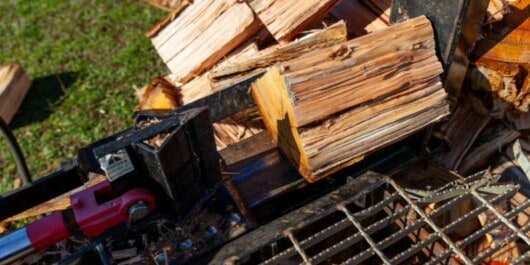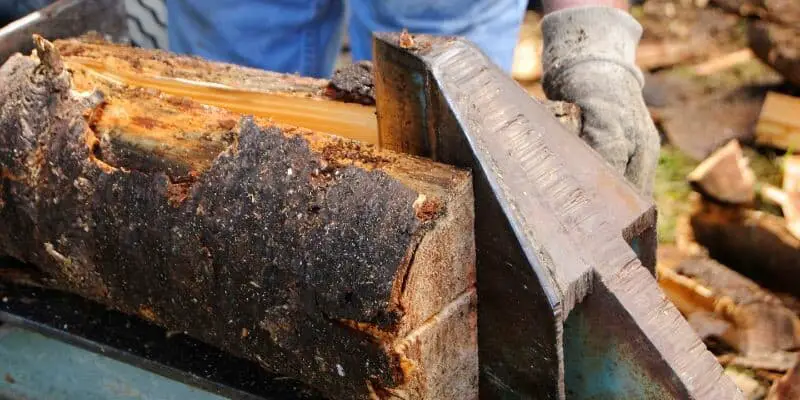Are you in the market for a new log splitter, but first want to know how does kinetic log splitter work? If so, then you’re definitely in the right place at the right time.
Kinetic log splitters work completely differently from traditional log splitters. While most log splitters in the market are hydraulic, meaning that the engine pushes oil into the hydraulic cylinder and the pressure of this oil pushes the ram through a log. These powerful machines come with an engine that turns two enormous flywheels. The motor of the kinetic log splitter will be connected to two flywheels with a belt.
When you start the motor, it’ll spin the flywheel and store kinetic energy in the spinning flywheels. When the handle is pulled, it’ll engage the rack and pinion system, which will work as a clutch. The energy will be released to the ram and the ram will shoot out at high speed, splitting the wooden logs.
In this guide, you will get to know all about kinetic log splitters, how does kinetic log splitter work, what are the advantages of using a kinetic log splitter, and more. Stick around to get all the answers that you’re looking for.
What is a kinetic log splitter?
Kinetic log splitters or kinetic splitters are extremely powerful tools for splitting wooden logs. These machines work completely differently from most other log splitters out there. Most log splitters are hydraulic, which means that the engine in these machines pushes oil into a hydraulic cylinder and the pressure of the oil pushes the ram through a log. Hydraulic log splitters are wonderful in a lot of aspects, namely that they can be quite powerful. When it comes to speed, these machines pale in comparison to kinetic log splitters.
A kinetic log splitter doesn’t make use of oil or hydraulics. Instead, these powerful machines come with an engine that turns two massive flywheels. The flywheels in these log splitters weigh between 55-75 lbs. depending upon the model you’ve chosen. Due to their weight, they store kinetic energy as they’re spinning. The heavier the flywheel, the more energy they’ll be able to store. The flywheels will turn a 5 lb. pinion gear that is made up of hardened steel.
When you’re engaging the handle of the log splitter, the rack will come down onto the pinion gear. This will push the ram out of the flywheel housing and through the wooden logs with a quick burst. The entire cycle time will be around 3-4 seconds. In comparison, the cycle times of hydraulic log splitters can be anywhere from 15 seconds to over a minute. Moreover, kinetic log splitters require a lot less maintenance as they have no valves or oil to worry about.
What do you mean by tonnage in a kinetic log splitter?
When you’re shopping for a kinetic log splitter, one of the first things that you should look for is tonnage. The tonnage refers to how much force the ram can exert on a log. The higher the tonnage, the bigger and tougher will be the logs that it can go through.
As the kinetic log splitters use speed instead of just brute force, it doesn’t actually have a tonnage rating in the same way that hydraulic log splitters do. It doesn’t mean that they aren’t as powerful, though.
How does kinetic log splitter work?
The log splitters that you normally find in the market are hydraulic log splitters. These powerful machines use a hydraulic pump for pumping oil into a hydraulic cylinder, which will slowly push the splitting ram to split logs. It’ll work well, but very slowly. You might have also heard of another type of log splitter – the kinetic log splitter. Here is how do kinetic log splitters work.
The motor in a kinetic log splitter is connected to two flywheels (to balance each side) with a belt and when you start the motor, it’ll spin the flywheel and store kinetic energy in the spinning flywheels. When you pull the handle, it engages the rack and pinion system, which will work as a clutch. The energy will be released to the ram while the ram will shoot out at high speed, splitting the wooden logs with great speed and force. The average cycle time will only be around 2.3 seconds or so.
What are the advantages of using a kinetic log splitter?
The most obvious and appealing part of a kinetic log splitter is that it is significantly faster than the hydraulic ones, almost six times faster. You’ll no longer have to sit around and wait for the hydraulic ram to go out and back slowly. Now, you can simply put the log on the splitter, pull the handle, and that’s it. Before you have time to put another one on, the ram has already returned and is ready for the next split, saving you valuable time in the process.
There are a few other benefits of using a kinetic log splitter as well –
1. Minimum maintenance
The maintenance needed with a kinetic log splitter is minimum. All you have to do is keep the log splitter and then lubricate the gears, and it’ll give you years of regular use. Moreover, there won’t be any oil leaks or pump issues.

2. Outsplit hydraulic log splitters
If you’ve got a tough piece of wood that you cannot split on the first attempt, you’ll be more likely to split it if you’re using a kinetic log splitter. These powerful machines use a thrust for crushing the logs, whereas hydraulic log splitters can only generate a steady force. Therefore, kinetic log splitters can “outsplit” hydraulic log splitters of the same level.
Interesting facts to know about kinetic log splitters
If you’re getting a kinetic log splitter, here are a few interesting facts to know about kinetic log splitters.
1. The full cycle time can be as little as 2.3 to 2.5 seconds
The cycle time on a log splitter is probably somewhere between the 15 to 30-second range. These seconds add up when you’re splitting cord after cord. With a kinetic log splitter, you should expect a cycle time of around 2.3 to 2.5 seconds, including auto-retract. It’ll make them around 6 times faster than most hydraulic models.
2. These machines aren’t measured in terms of tonnage
When you’re going shopping for a log splitter, the first thing that you should check is tonnage. This makes sense as in hydraulic log splitters, it is the best way of assessing their power. Kinetic log splitters cannot be accurately measured in terms of tons, as the force they produce will come in one quick thrust instead of prolonged pushes.
3. They are comparatively easier to maintain
With no pumps or hydraulic oil, kinetic log splitters will be much easier to maintain compared to hydraulic units. There will be no leaky valves or messy oil. The only maintenance that a kinetic log splitter requires is an engine tune-now now and then, similar to any other piece of machinery. Moreover, electric-powered log splitter models don’t even need that.
4. These powerful machines are available in powerful electric models
Electric log splitters are a great way of splitting wood indoors – say in your barn or shed. Otherwise, you won’t have the convenience of not having to deal with any gas or messy oil stains. Electric hydraulic log splitters are available only at low tonnages (3-ton, 5-ton, and more). It’s great for splitting kindling and other small logs, but what about big wooden logs? There are exceptional electric-powered kinetic log splitters that can out-split any 22-ton hydraulic logs.
5. Kinetic log splitters can handle tough logs
Kinetic log splitters will be able to handle any type of wooden log that hydraulic logs can – Tough ones and knotty ones to name a few. These powerful machines have the power to pop through even the most challenging wooden logs at a pace that you won’t believe.
6. Kinetic technology is nothing new
While using kinetic technology for splitting logs might be a relatively new concept, the system itself has been in use for ages. Modern machines have adapted this technology from mill machinery that was used during the US’ industrial heyday, where solid steel machines were built to last for years and years.
Conclusion
Thank you for reading. Hopefully, now you know a lot more about kinetic log splitters, how does kinetic log splitter work, what are the advantages of using a kinetic log splitter, and more. Kinetic log splitters work completely differently from traditional log splitters. While most log splitters in the market are hydraulic, meaning that the engine pushes oil into the hydraulic cylinder and the pressure of this oil pushes the ram through a log. These powerful machines come with an engine that turns two enormous flywheels. The motor of the kinetic log splitter will be connected to two flywheels with a belt.
When you start the motor, it’ll spin the flywheel and store kinetic energy in the spinning flywheels. When the handle is pulled, it’ll engage the rack and pinion system, which will work as a clutch. The energy will be released to the ram and the ram will shoot out at high speed, splitting the wooden logs.


